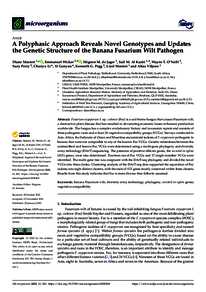Document
A polyphasic approach reveals novel genotypes and updates the genetic structure of the banana fusarium wilt pathogen.
Identifier
DOI: 10.3390/microorganisms10020269
Source
Microorganisms. v. 10, 2, 269
Contributors
Wicker, Emmanuel., Author
de Jager, Mignon M., Author
Al-Kaabi, Saif M. , Author
O’Neill, Wayne T. , Author
Perry, Suzy., Author
Li, Chunyu., Author
Ganyun, Yi., Author
Pegg, Kenneth G. , Author
Mostert, Lizel., Author
Viljoen, Altus., Author
Country
Switzerland
Publisher
MDPI.
Gregorian
2022-02-01
Language
English
Subject
English abstract
Fusarium oxysporum f. sp. cubense (Foc) is a soil-borne fungus that causes Fusarium wilt, a destructive plant disease that has resulted in devastating economic losses to banana production worldwide. The fungus has a complex evolutionary history and taxonomic repute and consists of three pathogenic races and at least 24 vegetative compatibility groups (VCGs). Surveys conducted in Asia, Africa, the Sultanate of Oman and Mauritius encountered isolates of F. oxysporum pathogenic to banana that were not compatible to any of the known Foc VCGs. Genetic relatedness between the undescribed and known Foc VCGs were determined using a multi-gene phylogeny and diversity array technology (DArT) sequencing. The presence of putative effector genes, the secreted in xylem (SIX) genes, were also determined. Fourteen novel Foc VCGs and 17 single-member VCGs were identified. The multi-gene tree was congruent with the DArT-seq phylogeny and divided the novel VCGs into three clades. Clustering analysis of the DArT-seq data supported the separation of Foc isolates into eight distinct clusters, with the suite of SIX genes mostly conserved within these clusters. Results from this study indicates that Foc is more diverse than hitherto assumed.
ISSN
2076-2607
Resource URL
Category
Journal articles

